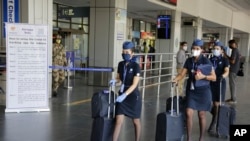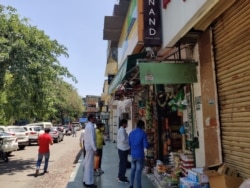Airline crews donned body protective suits and passengers arrived with masks as India resumed limited domestic flights on Monday after two months amid a gradual easing of lockdown restrictions.
The resumption of air services was accompanied with chaos and confusion as many passengers arrived at airports only to find that scores of flights had been cancelled after some of the worst affected states such as Maharashtra decided to limit air traffic into hotspots such as Mumbai.
The country threw open its skies even as it became the world’s 10th most affected nation after witnessing a record surge of coronavirus cases on Sunday to surpass Iran in the total number of infections.
“With the opening of the economy the infection rates are going to rise,” says Rajmohan Panda, a health expert at the Public Health Foundation of India. “But one should not look at the sheer numbers. We have to worry but there is no need to panic. The lockdown gave India time to fight the pandemic.”
India had halted all domestic and international flights in late March as it sought to stop the spread of coronavirus with the world's largest lockdown. But faced with the uphill task of reviving an economy battered by the pandemic, it is gradually opening up travel and allowing businesses to restart.
Taking a flight was a totally different experience from what it used to be – some passengers called it unnerving, while others said the strict protocols put in place made them confident about undertaking the journey.
Passengers had to arrive at least two hours before their flight, their luggage was sanitized and they had to undergo thermal screening even as security staff enforced strict new social distancing norms. They also verified that passengers had a government COVID-19 contact-tracing app on their phones. Some passengers donned face shields for extra protection against the virus. The hustle and bustle before the pandemic was replaced with a more somber mood.
Most passengers were headed back to hometowns – the lockdown announced with a four-hour notice, had caught many people off guard and left them stranded far away from families.
"Indians Soar In The Skies Again," Civil Aviation Minister Hardeep Puri tweeted.
Several states announced that passengers would have to undergo a mandatory quarantine in the cities to which they were headed.
On Sunday, 6,977 new cases took India’s total of coronavirus infections to 138,845 – nearly double the count 13 days ago. More than 4,000 people have died and health experts fear that India could emerge as one of the world’s hotspots after keeping its numbers relatively low compared to some Western countries.
“The fatality rate has not been that huge. Widespread projections which were given to number in tens of thousands did not happen and we have been able to avert many deaths,” says Panda. At the same time, he said India will have to ramp up surveillance and testing as it tries to fight off the virus.







